Christmas 2009 and a Giveaway!
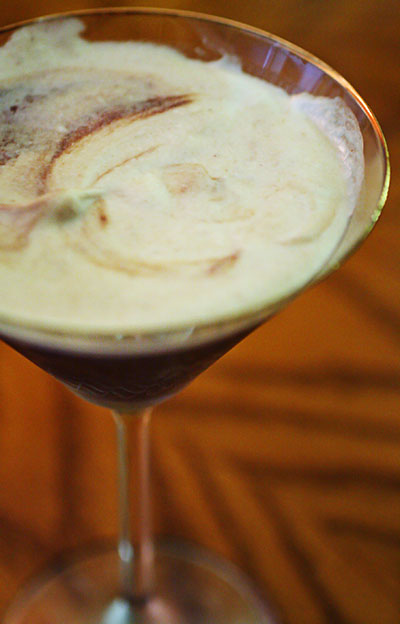 (Read to the end for a FotoCuisine Giveaway!)
(Read to the end for a FotoCuisine Giveaway!)
Every year, I do a four-course Christmas dinner for family. The number of guests range from 10 to 20 depending on the year, and to which cities family members are traveling over the holidays.
Each year, I do a theme. One year it was "wrapped" foods, one year was green and red. One year we had four hurricanes in Florida, so I picked courses based on the names of the hurricanes (Charley, Francis, Ivan, and Jeanne). Last year, I did an Iron Chef theme where guests picked the ingredient a week in advance.
This year, I struggled with a theme. Work and life pressure has been intense this year, like a good chunk of America. Both of my brothers and their families would be away this year, visiting in-laws, so the guest list was smaller than usual. My mother half suggested Christmas-on-a-budget, and it immediately resonated with me.
I wanted to still do a four course meal, but I wanted to keep it refined, yet inexpensive. We would have six adults this year, so I planned a meal under $100. Cooking staples already present in my parents' house (flour, mustard, olive oil, sugar, etc...) wouldn't count in the ingredient cost. I surprised myself when I planned the meal, went shopping, and ended up with a bill of $79.
I want to emphasize again that I wanted to keep things as refined as possible. Part of this goal was my own interest in cooking, and what I try to do to take my own cooking beyond the home and more into the realm of what restaurants try to accomplish. Another part was inspired by the demise this year of Gourmet Magazine. The fact that they did push for quality instead of populism may have, unfortunately, doomed them in the end, especially as their sister magazine, Bon Appetite, survived the axe.
Gourmet was my favorite cooking magazine, mainly for its unapologetic take on refined cuisine. From updated French sauces, to cooking lessons learned from grandmothers in a south Asian village, Gourmet always tried to go beyond the mainstream interest of the average American. For many editions, Gourmet didn't ride the emerging trend of culinary interest, they set the trend.
The term "refined" these days is almost a synonym for luxury or high-class, but the true meaning of the term is deeper than that. Refining is almost an engineering term -- taking what is wanted from a resource, and discarding what distracts from it. Jewelers will cut impurities from rough gems (rocks, really), facet and polish the center, and what is left is the essence of the mineral. Modern society, for better or worse, is literally driven by the refined, pure extract of sticky, tarry petroleum. The smelly syrup from moldy citrus rinds can be centrifuged, purified, and refined into the first (and still one of the most powerful) antibiotics.
Refined food these days is established by master artists and craftsmen of the cooking world. The Michelangelo-like perfection of Eric Ripert's seafood, the Hemingway-like minimalism of Thomas Keller, the Picasso-like jarring experimentation of Wylie Dufresne.
I'm light years out of that class, of course, but the concept of culinary refinement is still my inspiration when it comes to cooking. It may be the quest for making the perfect stock, or it may be as simple as trimming the store-bought skinless, boneless chicken breasts to remove that omnipresent chunk of gristle and blood vessels in the top corner and the occasional sliver of keelbone down the side.
As a quick aside, I'd like to admit that while refined food is my culinary inspiration, we don't eat like this every day. Personally, I find the Big Mac and fries to be a different sort of admirable culinary achievement -- not many cultures have evolved a way to deliver half a day's calories with all four food groups for the price of half an hour's minimum wage. There are plenty of negatives from obesity to the treatment of animals, but any society before the mid-20th century might find that these beat the real potentials of starvation and scurvy. When I was a kid, SciFi stories predicted that low-cost calories and nutrients would be delivered by nibbling on little pills every day (which alone might be a form of artless refinement). It turns out that fast food is cheaper.
So, to drag myself back to Christmas, refinement was my goal...but then again, I'm an evolving amateur at this. I went with classic techniques, and used local (and thus cheaper and healthier) ingredients when I could.
The Menu: Appetizer: Braised oxtail puff pastries, with braising liquid reduction sauce.
Soup: Classic French Onion soup, with consommé, Georgia sweet onions, crouton, and Gruyère.
Main: Local mahi-mahi with bacon, peppadew, goat cheese sauce, and side of fried sweet potato matchsticks.
Dessert: Dark chocolate mousse, layered with peanut butter mousse.
Each year, I plan the meal as a whole, but a dish jumps out as the star...and not usually the one I figured would shine. Last year, the coffee-glazed kingclip got rave reviews, when I was thinking the quail eggs Benedict was the perfect course.
This year, I came up with the oxtail puff pastries in about five minutes. They just kind of jelled in my mind, and I went on to other courses. I thought I did a really good job with the soup, and the dessert was excellent. I wasn't as happy with the mahi -- it was local and inexpensive, but then again, it isn't one of my favorite fish.
Anyway, the oxtail puff pastries blew everyone away. Everyone liked them so much that I used the rest of the oxtail meat and made more the next day. Then, the day after that, Christey reminded me that Pepperidge Farm and Foodbuzz had a New York giveaway contest for puff pastry recipes, and had given us a free coupon for Pepperidge Farm puff pastry. So, I made them one more time with more oxtails for our contest entry, and we had it three days in a row, and still weren't bored of it.
It might sound like these take a lot of time, but the oxtails basically cook themselves, and the puff pastry is already made by the experts at Pepperidge Farm, so this was a recipe that didn't call for much stress.
I seared four or five meaty oxtails in a pan with olive oil until brown on all sides, removed them, then seared some sliced carrots, parsnips, and shallots until soft and starting to brown. I returned the oxtails to the pan and filled halfway up the side with beef stock, a bit of red wine vinegar, and added a sprig of thyme and a couple peppadew peppers for sweetness and heat. I put this in a 300 degree oven for three hours, turning the oxtails once.
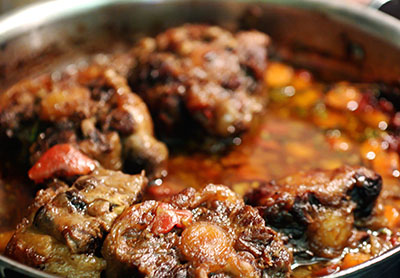
After the three hours, I took the oxtails out to cool, then pulled the meat off the bone (most of it just fell off, and my sister's dog enjoyed the bones as a Christmas treat). I took the rest of the braising liquid and simmered it to reduce by half.
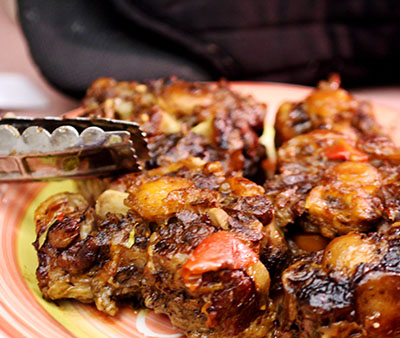
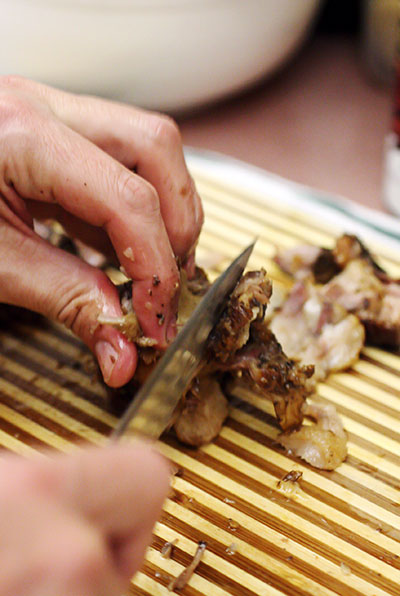
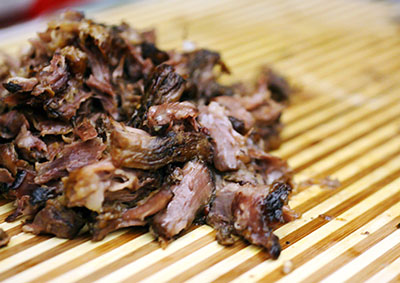
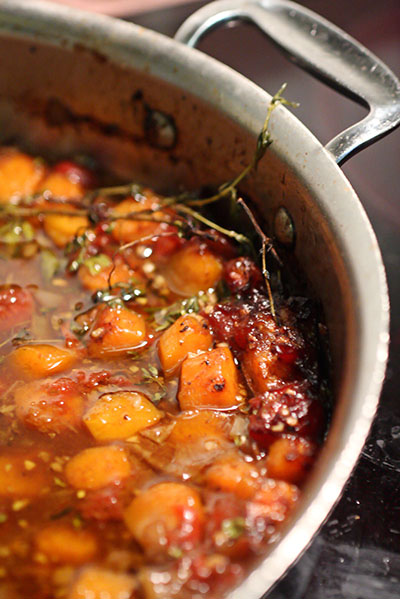
I cut triangles out of the puff pastry and placed a couple tablespoons of oxtail meat in the center, then placed another triangle over the top, pressing down on the sides to seal. I strained the sauce into a smaller saucepan and reduced that by half again.
I put the oxtail and puff pastries in a 400 degree preheated oven for about 15 minutes -- just until the tops were getting golden and the pastry was fluffy.
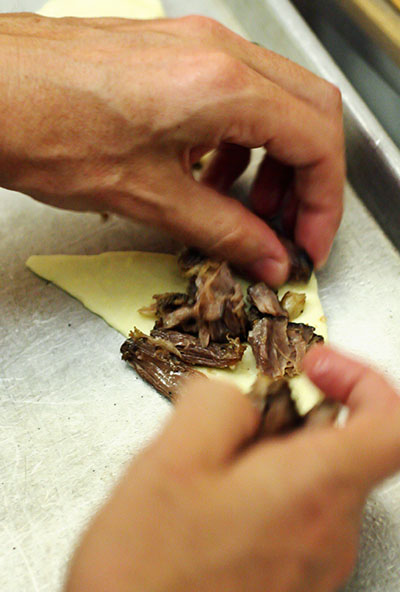
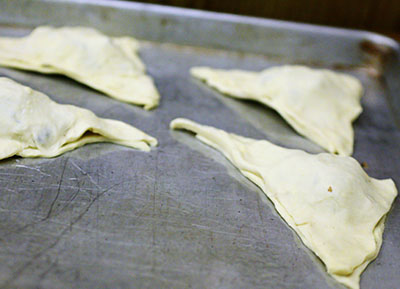
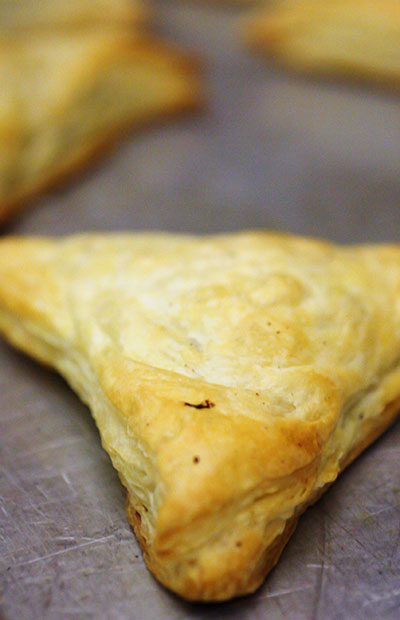
I drizzled some reduced sauce over the top, and they were ready to go.
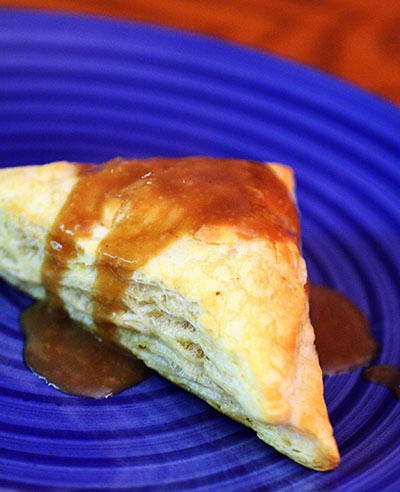
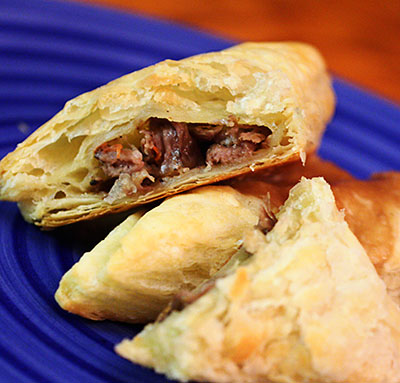
French onion soup was one of my first culinary adventures. As a 10-year old, the idea of eating a whole bowl of onions didn't immediately sound appetizing, but my family and I were having dinner at Cinderella Castle in Disney World. The menu mentioned cheese and toasted bread, which sold me, and my 10-year old mind was blown away by the soup.
The soup is usually made with slowly caramelized onions and beef broth, but I wanted to make the broth a little more refined than either the rustic preparation, or the broth-from-a-can (or worse, bullion cubes) recipes.
For the base of the soup, I bought some beef chuck cubes (stew meat). I made a broth out of the beef cubes by simmering in water with a mirepoix of carrots, celery, and shallots. After an hour or so, I got a flavorful, but murky broth. I strained the broth from the ingredients, then fine-diced some more cubes and mixed it with shredded carrots. I whipped up a couple egg whites, then put the veggies, eggs, diced meat, and carrots in a new pot and slowly brought it to a simmer -- the classic method for making a consommé. As the broth slowly came to a simmer, the egg whites coagulated into a thick mat on the top of the pot, trapping all the impurities in the broth. After 20-30 minutes, I carefully removed the mat and strained the rest of the broth through a fine strainer, and got a crystal-clear light beef broth.
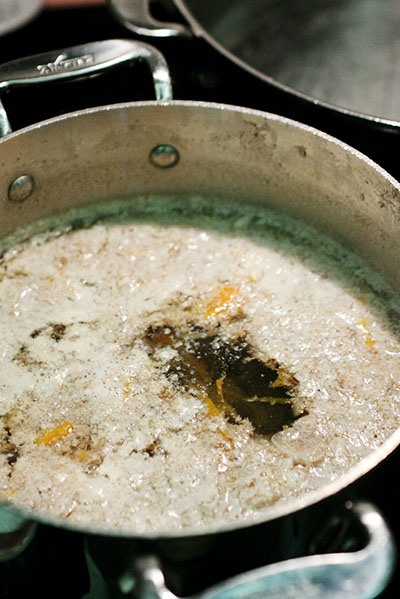
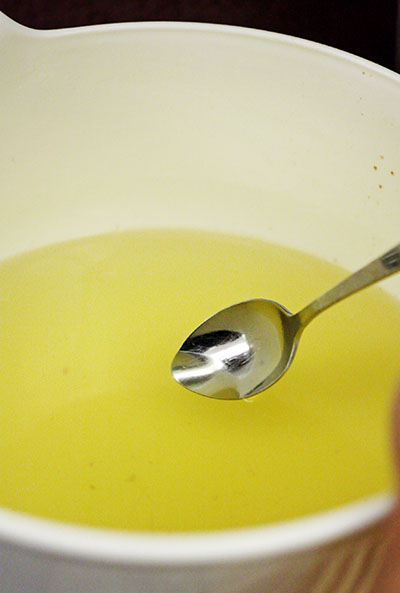
I sliced pounds of onions into half-slices, then sweated them with butter for 30-40 minutes, until they turned a golden brown.
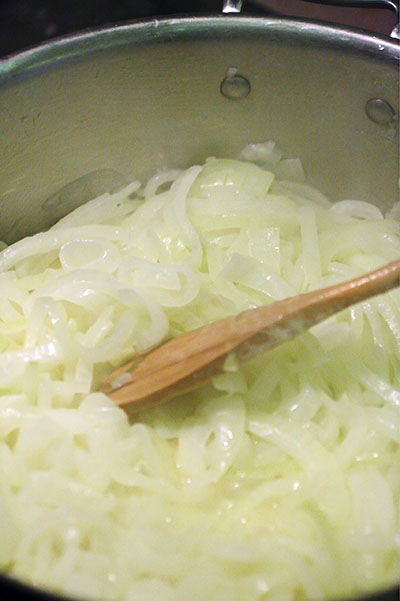
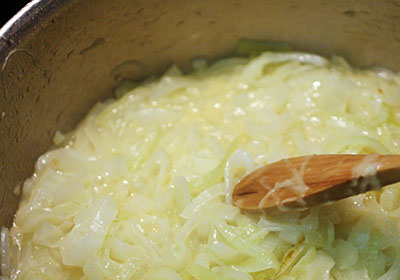
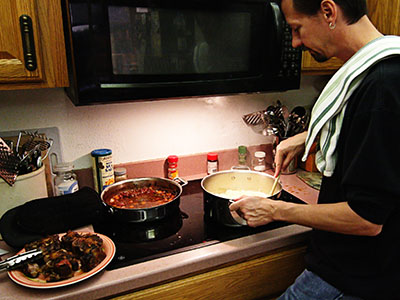
I bought some french bread, washed it with a bit of olive oil, and broiled it until crunchy and golden. I also bought some authentic Gruyère and shredded it into large shreds.
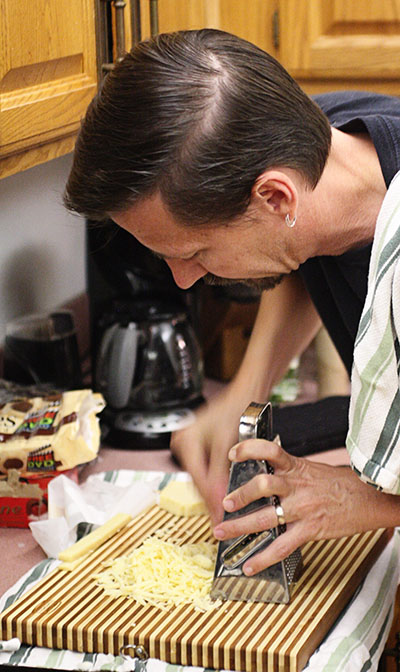
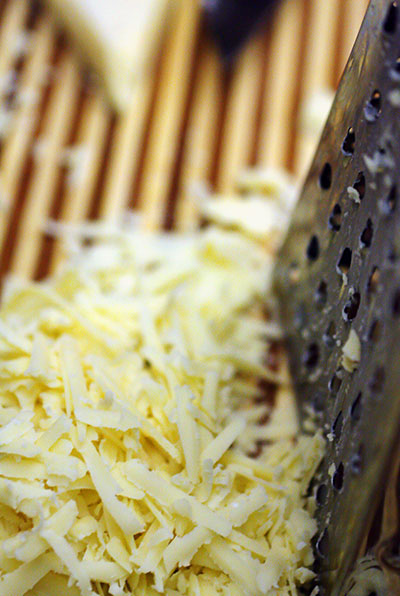
I ladled the soup, with a healthy serving of onions, into a ramekin, topped with the toasted bread, and sprinkled the cheese over that. Five minutes under the broiler, and it was done.
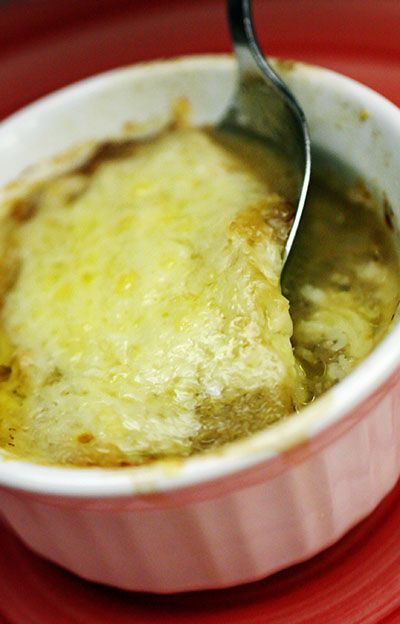
I've recently become a fan of peppadew peppers (as featured in our Grouper with Peppadew recipe). Even with goat cheese and imported peppers, this ended up being an economical dish. I was lucky enough to find an entire side of mahi for $13, which would easily portion out to feed six adults.
I fried up a couple slices of bacon, diced them, then reserved them to the side. I put 1/4 pound of peppadews into a small food processor and pulsed into a puree. I added them to a pan of sliced shallots, some more bacon, and chicken stock, then added a couple sprigs of thyme.
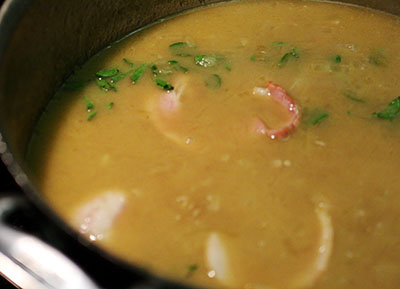
Meanwhile, I wished I had brought my mandolin. I peeled a couple sweet potatoes, then manually julienned them into matchsticks, which would have gone more quickly (and more evenly) with a mandolin. But, I sliced away, then fried the potatoes in approximately 375 degree vegetable oil for 5-6 minutes until crispy.
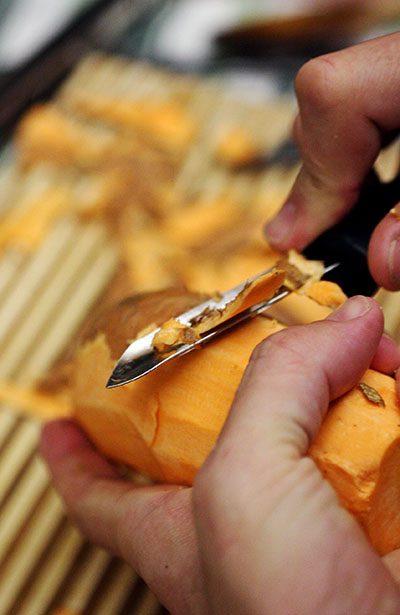
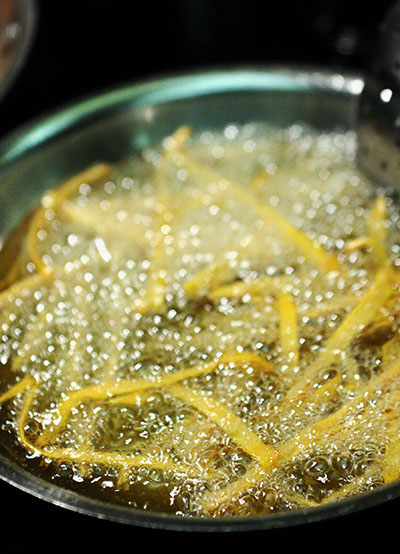
I pan-fried the mahi in olive oil after dusting each portion with flour, salt, and pepper. Once browned, I put the pan into a 400 degree oven for 10 minutes until they were done.
While the fish cooked, I added 3-4 ounces of French chevre goat cheese to the sauce until it melted and thickened everything nicely. I strained the sauce into a bowl, removed the fish from the oven, and put the plate of sweet potato fries in the oven to reheat as I plated the fish. Plating was fish, sauce, bacon, with a side pile of the potatoes.
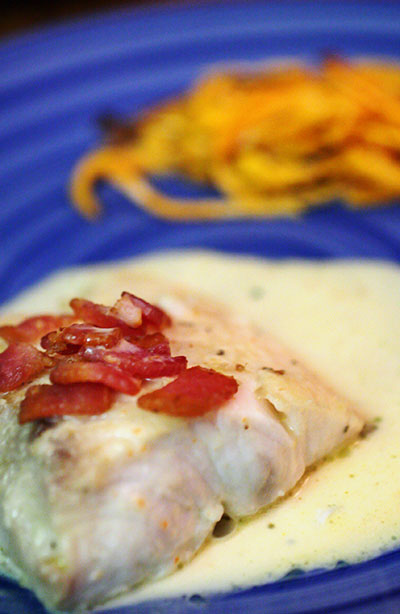
I have to say I was unhappy with this, and more than just the mahi. I originally thought of the fish sitting on a bed/nest of thin sweet potato shavings, but I couldn't pull it off -- they ended up being too thick. Matchstick fries were a good Plan B, but if I had more time, I would have tried to figure out a way to cut the potatoes into angel-hair-like threads, and flash-fry them in messy nest. The taste was there, the fish was cooked correctly, and the sauce was smooth and tasty, but it didn't quite match what I had originally tried to do.
Mousse is one of my favorite desserts, and it's a good test of basic food concepts. Separate three eggs. Heat some smashed up, good (Godiva) dark chocolate over a double boiler just barely hot enough to melt. Add egg yolks and just enough heavy cream to whisk into a syrup. Meanwhile, whip the egg whites and some sugar into stiff peaks. Whip some more heavy cream into stiff peaks. Then, gently fold chocolate, egg whites, and whipped cream into one smooth mixture. Chill in glasses, and that's an excellent chocolate mousse. Takes a lot of pots and bowls, but it's elegant.
I added to it this year by adding a layer of peanut butter mousse (Christey's a big fan of those Reese's peanut butter Christmas trees). I heated some peanut butter over a double-boiler and added enough cream to make it into a thick liquid. I then did the same with the egg white and whipped cream and made a peanut butter mousse.
I took martini glasses and wine glasses, added the dark chocolate mousse in the bottom, then layered the peanut butter mousse over the top. Chilled for a couple hours in the fridge, and it was heavenly.

The problem with being the cook is that I usually don't eat with the guests during Christmas. This year, I timed everything right so I could at least sit down for the main. Here I am, knife in hand, probably explaining something about the meal:
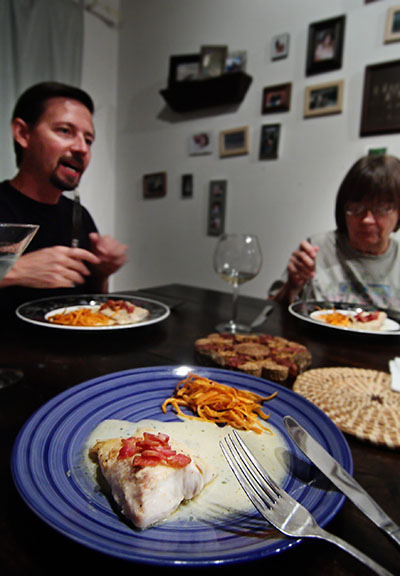
My Mom and my son Julian liked the mousse:
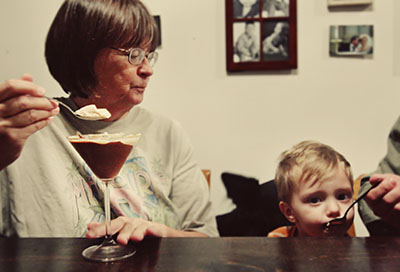
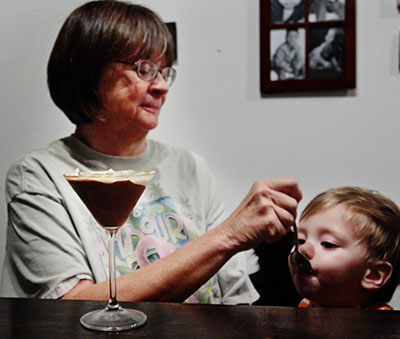
My 95-year-old Grandmother Mary liked the mousse, too:
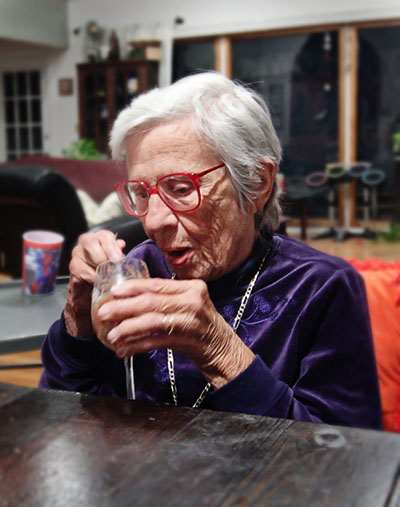 ------------------------------------------------------
------------------------------------------------------
Now that the holidays are over and life is returning to normal, we're hoping to post more than every couple weeks. In the next few days, we'll announce a new sponsorship which will allow us to give away some fun goodies. In the meantime, since Christey and I doubled-up on our San Francisco goodie-bags, we have a fun giveaway on this post.
We have some Apricot Conserve from Frog Hollow Farm, a jar of Italian Castelvetrano whole green olives from Mezzetta, and a goodie box from Made in Napa, including blackberry balsamic vinegar, spicy apple mustard with cinnamon, an herb rub with sea salt and spices, and some maple barbecue sauce with horseradish.
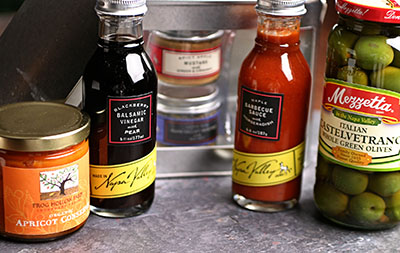
Leave a comment to this post, and we'll pick a random winner on January 18th to win the whole set of gourmet ingredients! No restrictions, anyone on Planet Earth can win, as long as you leave a valid email so we can get in touch with you for mailing instructions!



